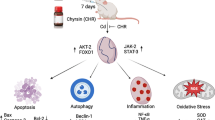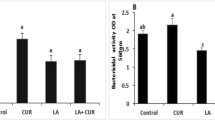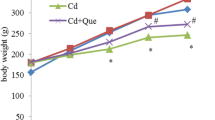Abstract
Mercuric chloride (HgCl2) is a heavy metal that is toxic to the human body. Carvacrol (CAR) is a flavonoid found naturally in plants and has many biological and pharmacological activities including anti-inflammatory, antioxidant, and anticancer activities. This study aimed to investigate the efficacy of CAR in HgCl2-induced testicular tissue damage. HgCl2 was administered intraperitoneally at a dose of 1.23 mg/kg body weight alone or in combination with orally administered CAR (25 mg/kg and 50 mg/kg body weight) for 7 days. Biochemical and histological methods were used to investigate oxidative stress, inflammation, apoptosis, and autophagy pathways in testicular tissue. CAR treatment increased HgCl2-induced decreased antioxidant enzyme (SOD, CAT, and GPx) activities and GSH levels. In addition, CAR reduced MDA levels, a marker of lipid peroxidation. CAR decreased the levels of inflammatory mediators NF-κB, TNF-α, IL-1β, COX-2, iNOS, MAPK14, MAPK15, and JNK. The increases in apoptotic Bax and Caspase-3 with HgCl2 exposure decreased with CAR, while the decreased antiapoptotic Bcl-2 level increased. CAR reduced HgCl2-induced autophagy damage by increasing Beclin-1, LC3A, and LC3B levels. Overall, the data from this study suggested that testicular tissue damage associated with HgCl2 toxicity can be mitigated by CAR administration.







Similar content being viewed by others
Data Availability
Data will be made available on request.
References
Safari F, Akramian M, Salehi-arjmand H, Khadivi A (2019) Physiological and molecular mechanisms underlying salicylic acid-mitigated mercury toxicity in lemon balm (Melissa officinalis L.). Ecotoxicol Environ Saf 183:109542
Almeer RS, Albasher G, Kassab RB, Ibrahim SR, Alotibi F, Alarifi S et al (2020) Ziziphus spina-christi leaf extract attenuates mercury chloride-induced testicular dysfunction in rats. Environ Sci Pollut Res Int 27(3):3401–3412
Albasher G, Alkahtani S, Alarifi S (2020) Berberine mitigates oxidative damage associated with testicular impairment following mercury chloride intoxication. J Food Biochem 44(9):e13385
Adelakun SA, Ukwenya VO, Akingbade GT, Omotoso OD, Aniah JA (2020) Interventions of aqueous extract of Solanum melongena fruits (garden eggs) on mercury chloride induced testicular toxicity in adult male Wistar rats. Biomed J 43(2):174–182
World Health Organization (WHO) (2017) Mercury and health. https://www.who.int/news-room/fact-sheets/detail/mercury-and-health. Accessed 05 Jun 2023
Gao PC, Chu JH, Chen XW, Li LX, Fan RF (2021) Selenium alleviates mercury chloride-induced liver injury by regulating mitochondrial dynamics to inhibit the crosstalk between energy metabolism disorder and NF-κB/NLRP3 inflammasome-mediated inflammation. Ecotoxicol Environ Saf 228:113018
Massányi P, Massányi M, Madeddu R, Stawarz R, Lukáč N (2020) Effects of cadmium, lead, and mercury on the structure and function of reproductive organs. Toxics 8(4):94
Li S, Han B, Wu P, Yang Q, Wang X, Li J et al (2022) Effect of inorganic mercury exposure on reproductive system of male mice: immunosuppression and fibrosis in testis. Environ Toxicol 37(1):69–78
Henriques MC, Loureiro S, Fardilha M, Herdeiro MT (2019) Exposure to mercury and human reproductive health: a systematic review. Reprod Toxicol 85:93–103
Kumar S, Sharma A, Sedha S (2022) Occupational and environmental mercury exposure and human reproductive health - a review. J Turk Ger Gynecol Assoc 23(3):199–210
Ruyani A, Muthmainnah D, Simatupang MB, Ramadhanti AP, Putri SR, Parlindungan D (2022) Etlingera hemisphaerica Blume attenuates male reproductive toxicity due to mercury chloride in Mus musculus. PREPRINT (Version 1) available at Research Square. https://doi.org/10.21203/rs.3.rs-2022132/v1
Nwahiri JD, Tamuno-Emine DG, Nwachuku EO, Bartimaeus ES (2021) Antioxidant potentials of Pentaclethra macrophylla seed (Ugba) on mercury toxicity induced hepatic, renal and testicular oxidative stress in male albino rats. JOCAMR 16(4):157–167
Kandemir FM, Caglayan C, Darendelioğlu E, Küçükler S, İzol E, Kandemir Ö (2021) Modulatory effects of carvacrol against cadmium-induced hepatotoxicity and nephrotoxicity by molecular targeting regulation. Life Sci 277:119610
Gur C, Akarsu SA, Akaras N, Tuncer SC, Kandemir FM (2023) Carvacrol reduces abnormal and dead sperm counts by attenuating sodium arsenite-induced oxidative stress, inflammation, apoptosis, and autophagy in the testicular tissues of rats. Environ Toxicol 38(6):1265–1276
Caglayan C, Kandemir FM, Darendelioğlu E, Yıldırım S, Kucukler S, Dortbudak MB (2019) Rutin ameliorates mercuric chloride-induced hepatotoxicity in rats via interfering with oxidative stress, inflammation and apoptosis. J Trace Elem Med Biol 56:60–68
Placer ZA, Cushman LL, Johnson BC (1966) Estimation of product of lipid peroxidation (malonyl dialdehyde) in biochemical systems. Anal Biochem 16(2):359–364
Aebi H (1984) Catalase in vitro. Methods Enzymol 105:121–126
Sun Y, Oberley LW, Li Y (1988) A simple method for clinical assay of superoxide dismutase. Clin Chem 34(3):497–500
Lawrence RA, Burk RF (2012) Glutathione peroxidase activity in selenium-deficient rat liver. 1976. Biochem Biophys Res Commun 425(3):503–509
Sedlak J, Lindsay RH (1968) Estimation of total, protein-bound, and nonprotein sulfhydryl groups in tissue with Ellman’s reagent. Anal Biochem 25(1):192–205
Lowry OH, Rosebrough NJ, Farr AL, Randall RJ (1951) Protein measurement with the Folin phenol reagent. J Biol Chem 193(1):265–275
Livak KJ, Schmittgen TD (2001) Analysis of relative gene expression data using real-time quantitative PCR and the 2−ΔΔCT method. Methods 25:402–408
Ileriturk M, Kandemir O, Kandemir FM (2022) Evaluation of protective effects of quercetin against cypermethrin-induced lung toxicity in rats via oxidative stress, inflammation, apoptosis, autophagy, and endoplasmic reticulum stress pathway. Environ Toxicol 37(11):2639–2650
Kandemir FM, Caglayan C, Aksu EH, Yildirim S, Kucukler S, Gur C et al (2020) Protective effect of rutin on mercuric chloride-induced reproductive damage in male rats. Andrologia 52(3):e13524
Gao PC, Wang AQ, Chen XW, Cui H, Li Y, Fan RF (2023) Selenium alleviates endoplasmic reticulum calcium depletion-induced endoplasmic reticulum stress and apoptosis in chicken myocardium after mercuric chloride exposure. Environ Sci Pollut Res Int 30(18):51531–51541
Caglayan C, Kandemir FM, Yildirim S, Kucukler S, Eser G (2019) Rutin protects mercuric chloride-induced nephrotoxicity via targeting of aquaporin 1 level, oxidative stress, apoptosis and inflammation in rats. J Trace Elem Med Biol 54:69–78
Wijesundara NM, Lee SF, Cheng Z, Davidson R, Rupasinghe HPV (2021) Carvacrol exhibits rapid bactericidal activity against Streptococcus pyogenes through cell membrane damage. Sci Rep 11(1):1487
Chainy GBN, Sahoo DK (2020) Hormones and oxidative stress: an overview. Free Radic Res 54(1):1–26
Akaras N, Gur C, Kucukler S, Kandemir FM (2023) Zingerone reduces sodium arsenite-induced nephrotoxicity by regulating oxidative stress, inflammation, apoptosis and histopathological changes. Chem Biol Interact 374:110410
Seif M, Abd El-Aziz T, Sayed M, Wang Z (2021) Zingiber officinale ethanolic extract attenuates oxidative stress, steroidogenic gene expression alterations, and testicular histopathology induced by sodium arsenite in male rats. Environ Sci Pollut Res Int 28(16):19783–19798
Panneerselvam L, Raghunath A, Ravi MS, Vetrivel A, Subramaniam V, Sundarraj K, Perumal E (2020) Ferulic acid attenuates arsenic-induced cardiotoxicity in rats. Biotechnol Appl Biochem 67(2):186–195
Kim SH, Sharma RP (2005) Mercury alters endotoxin-induced inflammatory cytokine expression in liver: differential roles of p38 and extracellular signal-regulated mitogen-activated protein kinases. Immunopharmacol Immunotoxicol 27(1):123–135
Sharma MK, Sharma A, Kumar A, Kumar M (2007) Spirulina fusiformis provides protection against mercuric chloride induced oxidative stress in Swiss albino mice. Food Chem Toxicol 45(12):2412–2419
Li LX, Chu JH, Chen XW, Gao PC, Wang ZY, Liu C, Fan RF (2022) Selenium ameliorates mercuric chloride-induced brain damage through activating BDNF/TrKB/PI3K/AKT and inhibiting NF-κB signaling pathways. J Inorg Biochem 229:111716. https://doi.org/10.1016/j.jinorgbio.2022.111716
Chen XW, Chu JH, Li LX, Gao PC, Wang ZY, Fan RF (2022) Protective mechanism of selenium on mercuric chloride-induced testis injury in chicken via p38 MAPK/ATF2/iNOS signaling pathway. Theriogenology 187:188–194
Rathod NB, Kulawik P, Ozogul F, Regenstein JM, Ozogul Y (2021) Biological activity of plant-based carvacrol and thymol and their impact on human health and food quality. Trends Food Sci Technol 116:733–748
Shoorei H, Khaki A, Khaki AA, Hemmati AA, Moghimian M, Shokoohi M (2019) The ameliorative effect of carvacrol on oxidative stress and germ cell apoptosis in testicular tissue of adult diabetic rats. Biomed Pharmacother 111:568–578
Gur C, Kandemir FM, Darendelioglu E, Caglayan C, Kucukler S, Kandemir O et al (2021) Morin protects against acrylamide-induced neurotoxicity in rats: an investigation into different signal pathways. Environ Sci Pollut Res Int 28(36):49808–49819
Kucukler S, Caglayan C, Darendelioğlu E, Kandemir FM (2020) Morin attenuates acrylamide-induced testicular toxicity in rats by regulating the NF-κB, Bax/Bcl-2 and PI3K/Akt/mTOR signaling pathways. Life Sci 261:118301
Simsek H, Akaras N (2023) Acacetin ameliorates acetylsalicylic acid-induced gastric ulcer in rats by interfering with oxidative stress, inflammation, and apoptosis. Int J Med Biochem 6(2):96–103
Şimşek H, Akaras N, Gür C, Küçükler S, Kandemir FM (2023) Beneficial effects of chrysin on cadmium-induced nephrotoxicity in rats: modulating the levels of Nrf2/HO-1, RAGE/NLRP3, and Caspase-3/Bax/Bcl-2 signaling pathways. Gene 875:147502
Elshawi OE, Nabeel AI (2019) Modulatory effect of a new benzopyran derivative via COX-2 blocking and down regulation of NF-κB against γ-radiation induced- intestinal inflammation. J Photochem Photobiol B 192:90–96
Yesildag K, Gur C, Ileriturk M, Kandemir FM (2022) Evaluation of oxidative stress, inflammation, apoptosis, oxidative DNA damage and metalloproteinases in the lungs of rats treated with cadmium and carvacrol. Mol Biol Rep 49(2):1201–1211
Çelik H, Kucukler S, Çomaklı S, Caglayan C, Özdemir S, Yardım A, Karaman M, Kandemir FM (2020) Neuroprotective effect of chrysin on isoniazid-induced neurotoxicity via suppression of oxidative stress, inflammation and apoptosis in rats. Neurotoxicology 81:197–208
Singh A, Nath O, Singh S, Kumar S, Singh IK (2018) Genome-wide identification of the MAPK gene family in chickpea and expression analysis during development and stress response. Plant Gene 13:25–35
Madkour MM, Anbar HS, El-Gamal MI (2021) Current status and future prospects of p38α/MAPK14 kinase and its inhibitors. Eur J Med Chem 213:113216
Ileriturk M, Kandemir O, Akaras N, Simsek H, Genc A, Kandemir FM (2023) Hesperidin has a protective effect on paclitaxel-induced testicular toxicity through regulating oxidative stress, apoptosis, inflammation and endoplasmic reticulum stress. Reprod Toxicol 118:108369
Akaras N, Abuc OO, Koc K, Bal T, Geyikoglu F, Atilay H, Erol HS, Yigit S, Gul M (2020) (1 → 3)-β-d-glucan enhances the toxicity induced by Bortezomib in rat testis. J Food Biochem 44(3):e13155
Akaras N, Bal T, Atilay H, Selli J, Halici MB (2017) Protective effects of agomelatine on testicular damage caused by bortezomib. Biotech Histochem 92(8):552–559
Han B, Li S, Lv Y, Yang D, Li J, Yang Q, Wu P, Lv Z, Zhang Z (2019) Dietary melatonin attenuates chromium-induced lung injury via activating the Sirt1/Pgc-1α/Nrf2 pathway. Food Funct 10(9):5555–5565
Han B, Lv Z, Han X, Li S, Han B, Yang Q, Wang X, Wu P, Li J, Deng N, Zhang Z (2022) Harmful effects of inorganic mercury exposure on kidney cells: mitochondrial dynamics disorder and excessive oxidative stress. Biol Trace Elem Res 200(4):1591–1597
Li S, Baiyun R, Lv Z, Li J, Han D, Zhao W, Yu L, Deng N, Liu Z, Zhang Z (2019) Exploring the kidney hazard of exposure to mercuric chloride in mice:disorder of mitochondrial dynamics induces oxidative stress and results in apoptosis. Chemosphere 234:822–829
Akcılar R, Akcılar A, Koçak C, Koçak FE, Bayat Z, Şimşek H et al (2015) Effects of Ukrain on intestinal apoptosis caused by ischemia-reperfusion injury in rats. Int J Clin Exp Med 8(12):22158–22166
Şimşek H, Demiryürek Ş, Demir T, Atabay HD, Çeribasi AO, Bayraktar R et al (2016) Assessment of expressions of Bcl-XL, b-FGF, Bmp-2, Caspase-3, PDGFR-α, Smad1 and TGF-β1 genes in a rat model of lung ischemia/reperfusion. Iran J Basic Med Sci 19(2):209–214
Şimşek H, Küçükler S, Gür C, Akaras N, Kandemir FM (2023) Protective effects of sinapic acid against lead acetate-induced nephrotoxicity: a multi-biomarker approach. Environ Sci Pollut Res Int 30(45):101208–101222
Şimşek H, Küçükler S, Gür C, İleritürk M, Aygörmez S, Kandemir FM (2023) Protective effects of zingerone against sodium arsenite-induced lung toxicity: a multi-biomarker approach. Iran J Basic Med Sci 26(9):1098–1106
Wang XS, Liu C, Khoso PA, Zheng W, Li M, Li S (2017) Autophagy response in the liver of pigeon exposed to avermectin. Environ Sci Pollut Res Int 24(14):12767–12777
Martin LM, Jeyabalan N, Tripathi R, Panigrahi T, Johnson PJ, Ghosh A et al (2019) Autophagy in corneal health and disease: a concise review. Ocul Surf 17(2):186–197
Aydin M, Cevik A, Kandemir FM, Yuksel M, Apaydin AM (2009) Evaluation of hormonal change, biochemical parameters, and histopathological status of uterus in rats exposed to 50-Hz electromagnetic field. Toxicol Ind Health 25(3):153–158
Li R, Luo X, Li L, Peng Q, Yang Y, Zhao L et al (2016) The protective effects of melatonin against oxidative stress and inflammation induced by acute cadmium exposure in mice testis. Biol Trace Elem Res 170(1):152–164
Rotimi DE, Olaolu TD, Adeyemi OS (2022) Pharmacological action of quercetin against testicular dysfunction: a mini review. J Integr Med 20(5):396–401
Zhang S, Niu Q, Gao H, Ma R, Lei R, Zhang C et al (2016) Excessive apoptosis and defective autophagy contribute to developmental testicular toxicity induced by fluoride. Environ Pollut 212:97–104
Anyanwu BO, Ezejiofor AN, Nwaogazie IL, Akaranta O, Orisakwe OE (2020) Low-dose heavy metal mixture (lead, cadmium and mercury)-induced testicular injury and protective effect of zinc and Costus afer in Wistar albino rats. Andrologia 52(9):e13697
Acknowledgements
We would like to thank Prof. Dr. Mehmet Tuğrul Yılmaz, İbrahim Yıldız, and KONUDAM team for their support.
Author information
Authors and Affiliations
Contributions
The authors’ contribution as follows was accepted by all authors: Hasan Şimşek: research, methodology, investigation. Cihan Gür, Mustafa İleritürk, Sefa Küçükler, and Mehmet Öz: methodology, investigation, data curation, formal analysis. Nurhan Akaras: methodology, investigation, histopathological examination. Fatih Mehmet Kandemir: investigation, formal analysis, supervision. Hasan Şimşek wrote the first draft of the article. All authors read and approved the final manuscript.
Corresponding author
Ethics declarations
Ethical Approval
Ethics committee approval was received for this study from the ethics committee of Necmettin Erbakan University KONUDAM Experimental Medicine Research and Study Center’s (No: 2022/048, Date: 25 Aug 2022).
Consent to Participate
The authors gave their explicit consent to publish the manuscript. Hasan Şimşek is free to contact any of the people involved in the research to seek further clarification and information.
Consent to Publish
Not applicable.
Competing Interests
The authors declare no competing interests.
Additional information
Publisher's Note
Springer Nature remains neutral with regard to jurisdictional claims in published maps and institutional affiliations.
Rights and permissions
Springer Nature or its licensor (e.g. a society or other partner) holds exclusive rights to this article under a publishing agreement with the author(s) or other rightsholder(s); author self-archiving of the accepted manuscript version of this article is solely governed by the terms of such publishing agreement and applicable law.
About this article
Cite this article
Şimşek, H., Gür, C., Küçükler, S. et al. Carvacrol Reduces Mercuric Chloride-Induced Testicular Toxicity by Regulating Oxidative Stress, Inflammation, Apoptosis, Autophagy, and Histopathological Changes. Biol Trace Elem Res (2023). https://doi.org/10.1007/s12011-023-04022-2
Received:
Accepted:
Published:
DOI: https://doi.org/10.1007/s12011-023-04022-2




